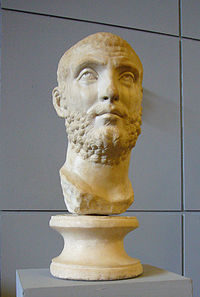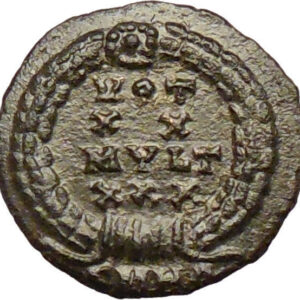|
Carinus – Roman Emperor: 283-285 A.D. –
Bronze Antoninianus 22mm (3.12 grams) Rome mint: 284-285 A.D.
Reference: RIC 243c, C 11
IMPCMAVRCARINVSAVG – Radiate, draped and cuirassed bust right.
AETERNITAVGG Exe: KAΓ – Aeternitas
standing left, holding phoenix on globe and raising skirt.
You are bidding on the exact
item pictured, provided with a Certificate of Authenticity and Lifetime
Guarantee of Authenticity.
Eternity (or forever) is endless
time. It is often referenced in the context of
religion, in the concept of
immortality, whereby
death is conquered, and people may live for an
unlimited amount of time (cf.
Heaven). The existence of gods or
God
is said to endure eternally and sometimes also the natural cosmos, in respect to
both past and future.
By contrast, the concept of a mathematically
infinite duration, is called sempiternity
or everlasting. Whereas the eternal is said to be
unchanging and outside time; a potentially
sempiternal span of time can never come to pass in actuality.[1]
Aristotle
argued that
cosmos has no beginning.
The idea of eternity
The
metaphysics of eternity studies that which
necessarily exists “outside” or independently of
space and time. Another important question is
whether “information”
or
Form is separable from
mind and
matter.
God and eternity
Theists say that
God is eternally existent. How this is
understood depends on which definition of eternity is used. On one hand, God may
exist in eternity, a timeless existence where categories of past,
present, and future just do not apply. On the other hand, God will exist for
or through eternity, or at all times, having already existed for
an infinite amount of time and continuing to exist for an infinite amount of
time. One other definition states that God exists outside the human concept of
time, but also inside of time. The reasoning for this definition is that if God
did not exist both outside time and inside time, God would not be able to
interact with humans.
Aristotle established a distinction between
actual infinity and a potentially infinite
count, for example, instead of saying that there are an infinity of primes,
Euclid prefers instead to say that there are
more prime numbers than contained in any given collection of prime numbers.[2]
According to Aristotle, a future span of time must be a potential infinity,
because another element can always be added to a series that is inexhaustible:
“For generally the infinite has this mode of existence: one thing is always
being taken after another, and each thing that is taken is always finite, but
always different”.[3]
Augustine of Hippo wrote that time exists only
within the created universe, so that God exists outside time:
In the eminence of thy ever-present eternity, thou precedest all times
past, and extendest beyond all future times, for they are still to come
– and when they have come, they will be past. But “Thou art always the
Selfsame and thy years shall have no end.” Thy years neither go nor
come; but ours both go and come in order that all separate moments may
come to pass. All thy years stand together as one, since they are
abiding. Nor do thy years past exclude the years to come because thy
years do not pass away. All these years of ours shall be with thee, when
all of them shall have ceased to be. Thy years are but a day, and thy
day is not recurrent, but always today. Thy “today” yields not to
tomorrow and does not follow yesterday. Thy “today” is eternity.[4]
-St. Augustine, Confessions, Book XI, Chapter XIII
See all the biblical passage 2Pe:3:8: “But, beloved, be not ignorant of this
one thing, that one day is with the Lord as a thousand years, and a thousand
years as one day.”
Symbolism
Eternity is often symbolized by the image of a snake swallowing its own tail,
known as
Ouroboros (or Uroboros), though the symbol can
also carry a number of other connotations.
The circle is also commonly used as a symbol for eternity. The related
concept,
infinity, is symbolized by
 , ,
which may be based on the Ouroboros.
The phoenix is a
mythical
sacred
firebird that originated in
Persian mythology, ancient
Phoenician
mythology (according to
Sanchuniathon),
Chinese mythology,
Egyptian religion and later
Greek mythology.
A phoenix is a mythical bird that is a fire spirit with a colorful plumage
and a tail of gold and scarlet (or purple, blue, and green according to some
legends). It has a 500 to 1,000 year life-cycle, near the end of which it builds
itself a nest of twigs that then ignites; both nest and bird burn fiercely and
are reduced to ashes, from which a new, young phoenix or phoenix egg arises,
reborn anew to live again. The new phoenix is destined to live as long as its
old self. In some stories, the new phoenix embalms the ashes of its old self in
an egg made of myrrh and deposits it in the Egyptian city of
Heliopolis (Greek
for sun-city). It is said that the bird’s cry is that of a beautiful song. In
very few stories they are able to change into people.
The Roman poet
Ovid
wrote the following about the phoenix:
Most beings spring from other individuals; but there is a certain kind
which reproduces itself. The Assyrians call it the Phoenix. It does not live
on fruit or flowers, but on frankincense and odoriferous gums. When it has
lived five hundred years, it builds itself a nest in the branches of an oak,
or on the top of a palm tree. In this it collects cinnamon, and spikenard,
and myrrh, and of these materials builds a pile on which it deposits itself,
and dying, breathes out its last breath amidst odors. From the body of the
parent bird, a young Phoenix issues forth, destined to live as long a life
as its predecessor. When this has grown up and gained sufficient strength,
it lifts its nest from the tree (its own cradle and its parent’s sepulchre),
and carries it to the city of Heliopolis in Egypt, and deposits it in the
temple of the Sun.
French author
Voltaire
thus described the phoenix:
It was of the size of an eagle, but its eyes were as mild and tender as
those of the eagle are fierce and threatening. Its beak was the color of a
rose, and seemed to resemble, in some measure, the beautiful mouth of
Formosante. Its neck resembled all the colors of the rainbow, but more
brilliant and lively. A thousand shades of gold glistened on its plumage.
Its feet seemed a mixture of purple and silver; and the tail of those
beautiful birds which were afterwards fixed to the car of Juno, did not come
near the beauty of its tail.
Marcus
Aurelius Carinus (died 285) was
Roman
Emperor (283 – July, 285) and elder son of the Emperor
Carus, on whose
accession he was appointed governor of the western portion of the empire.
 He fought with success against the He fought with success against the
Quadi tribes,
but soon left the defence of the Upper
Rhine to his
legates and returned to
Rome, where he abandoned himself to all kinds of debauchery and excess. He
also celebrated the ludi Romani on a scale of unexampled magnificence.
After the death of Carus, the army in the East demanded to be led back to
Europe, and
Numerian, the younger son of Carus, was forced to comply.
During a halt at
Chalcedon,
Numerian was found dead, and
Diocletian,
commander of the body-guards, who had claimed that Numerian had been
assassinated, was proclaimed emperor by the soldiers.
Carinus at once left Rome and set out for the East to meet Diocletian. On his
way through Pannonia he put down the usurper
Sabinus Iulianus, and encountered the army of Diocletian in
Moesia.
Carinus was successful in several engagements, and at the
Battle of the Margus River (Morava),
according to one account, the valour of his troops had gained the day, when he
was assassinated by a tribune whose wife he had seduced. In another account, the
battle is represented as having resulted in a complete victory for Diocletian,
for Carinus’ army deserted him: this second account is also confirmed by the
fact that Diocletian kept Carinus’ Praetorian Guard commander in service.
Carinus has the reputation of having been one of the worst of the emperors.
This infamy was possibly supported by Diocletian himself. For example,
Historia Augusta has Carinus marrying nine wives, while neglecting to
mention his only real wife,
Magnia Urbica, by whom he had an only son, Marcus Aurelius Nigrinianus.
After his death, Carinus’
memory was condemned and his name, along with that of his wife, was erased
from inscriptions.
|






 ,
, 
 He fought with success against the
He fought with success against the


